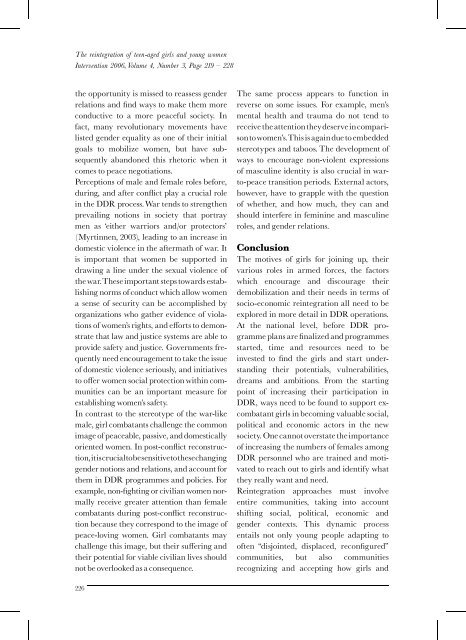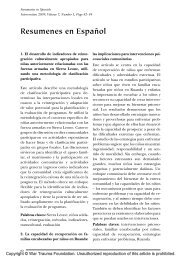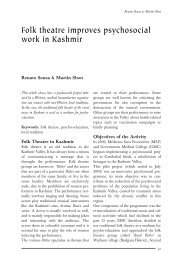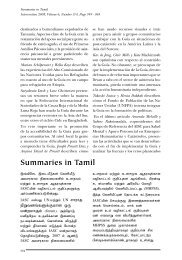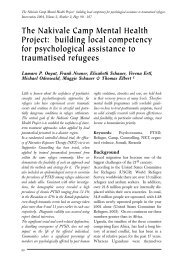The reintegration of teenage girls and young women
The reintegration of teenage girls and young women
The reintegration of teenage girls and young women
Create successful ePaper yourself
Turn your PDF publications into a flip-book with our unique Google optimized e-Paper software.
<strong>The</strong> <strong>reintegration</strong> <strong>of</strong> teen-aged <strong>girls</strong> <strong>and</strong> <strong>young</strong> <strong>women</strong><br />
Intervention 2006, Volume 4, Number 3, Page 219 ^ 228<br />
the opportunity is missed to reassess gender<br />
relations <strong>and</strong> ¢nd ways to make them more<br />
conductive to a more peaceful society. In<br />
fact, many revolutionary movements have<br />
listed gender equality as one <strong>of</strong>their initial<br />
goals to mobilize <strong>women</strong>, but have subsequently<br />
ab<strong>and</strong>oned this rhetoric when it<br />
comes to peace negotiations.<br />
Perceptions <strong>of</strong>male <strong>and</strong> female roles before,<br />
during, <strong>and</strong> after con£ict play a crucial role<br />
in the DDR process.War tends to strengthen<br />
prevailing notions in society that portray<br />
men as ‘either warriors <strong>and</strong>/or protectors’<br />
(Myrtinnen, 2003), leading to an increase in<br />
domestic violence in the aftermath <strong>of</strong> war. It<br />
is important that <strong>women</strong> be supported in<br />
drawing a line under the sexual violence <strong>of</strong><br />
thewar.<strong>The</strong>se important stepstowards establishing<br />
norms <strong>of</strong>conduct which allow <strong>women</strong><br />
a sense <strong>of</strong>security can be accomplished by<br />
organizations who gather evidence <strong>of</strong>violations<br />
<strong>of</strong><strong>women</strong>’s rights, <strong>and</strong> e¡orts to demonstrate<br />
that law <strong>and</strong> justice systems are able to<br />
provide safety <strong>and</strong> justice. Governments frequently<br />
need encouragement to take the issue<br />
<strong>of</strong>domestic violence seriously, <strong>and</strong> initiatives<br />
to o¡er <strong>women</strong> social protection within communities<br />
can be an important measure for<br />
establishing <strong>women</strong>’s safety.<br />
In contrast to the stereotype <strong>of</strong>the war-like<br />
male, girl combatants challenge the common<br />
image <strong>of</strong>peaceable, passive, <strong>and</strong>domestically<br />
oriented <strong>women</strong>. In post-con£ict reconstruction,itiscrucialtobesensitivetothesechanging<br />
gender notions <strong>and</strong> relations, <strong>and</strong> account for<br />
them in DDR programmes <strong>and</strong> policies. For<br />
example, non-¢ghting or civilian <strong>women</strong> normally<br />
receive greater attention than female<br />
combatants during post-con£ict reconstruction<br />
because they correspond to the image <strong>of</strong><br />
peace-loving <strong>women</strong>. Girl combatants may<br />
challenge this image, but their su¡ering <strong>and</strong><br />
their potential for viable civilian lives should<br />
notbe overlookedas a consequence.<br />
226<br />
<strong>The</strong> same process appears to function in<br />
reverse on some issues. For example, men’s<br />
mental health <strong>and</strong> trauma do not tend to<br />
receivetheattentiontheydeserveincomparisonto<strong>women</strong>’s.This<br />
isagainduetoembedded<br />
stereotypes <strong>and</strong> taboos. <strong>The</strong> development <strong>of</strong><br />
ways to encourage non-violent expressions<br />
<strong>of</strong>masculine identity is also crucial in warto-peace<br />
transition periods. External actors,<br />
however, have to grapple with the question<br />
<strong>of</strong>whether, <strong>and</strong> how much, they can <strong>and</strong><br />
should interfere in feminine <strong>and</strong> masculine<br />
roles, <strong>and</strong> gender relations.<br />
Conclusion<br />
<strong>The</strong> motives <strong>of</strong><strong>girls</strong> for joining up, their<br />
various roles in armed forces, the factors<br />
which encourage <strong>and</strong> discourage their<br />
demobilization <strong>and</strong> their needs in terms <strong>of</strong><br />
socio-economic <strong>reintegration</strong> all need to be<br />
explored in more detail in DDR operations.<br />
At the national level, before DDR programme<br />
plans are ¢nalized <strong>and</strong>programmes<br />
started, time <strong>and</strong> resources need to be<br />
invested to ¢nd the <strong>girls</strong> <strong>and</strong> start underst<strong>and</strong>ing<br />
their potentials, vulnerabilities,<br />
dreams <strong>and</strong> ambitions. From the starting<br />
point <strong>of</strong>increasing their participation in<br />
DDR, ways need to be found to support excombatant<br />
<strong>girls</strong> in becoming valuable social,<br />
political <strong>and</strong> economic actors in the new<br />
society. One cannotoverstatethe importance<br />
<strong>of</strong>increasing the numbers <strong>of</strong>females among<br />
DDR personnel who are trained <strong>and</strong> motivated<br />
to reach out to <strong>girls</strong> <strong>and</strong> identify what<br />
they really want <strong>and</strong> need.<br />
Reintegration approaches must involve<br />
entire communities, taking into account<br />
shifting social, political, economic <strong>and</strong><br />
gender contexts. This dynamic process<br />
entails not only <strong>young</strong> people adapting to<br />
<strong>of</strong>ten ‘‘disjointed, displaced, recon¢gured’’<br />
communities, but also communities<br />
recognizing <strong>and</strong> accepting how <strong>girls</strong> <strong>and</strong>


